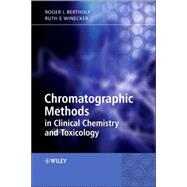
Dr R.E. Winecker, Chief Toxicologist, North Carolina Office of the Chief Medical Examiner.
| Preface | |
| List of Contributors | |
| Quality Assurance, Quality Control and Method Validation in Chromatographic Applications | |
| Introduction | |
| History | |
| Definition of Quality Assurance and Quality Control | |
| Professional Organizations | |
| Internal Quality Assurance and Control | |
| Standard operating procedure manual | |
| Method development | |
| Method validation | |
| Accuracy | |
| Precision | |
| Recovery | |
| Lower limits of detection (sensitivity) and quantitation | |
| Range of linearity | |
| Specificity | |
| Stability | |
| Carryover | |
| Ruggedness | |
| Selection of a reference standard | |
| Selection of an internal standard and standard addition | |
| Selection of derivatization agent | |
| Selection of ions for selected-ion monitoring or full-scan analysis | |
| Chromatographic performance | |
| Statistical evaluation of quality control | |
| External Quality Assurance | |
| References | |
| Liquid Chromatographic-Mass Spectrometric Measurement of Anabolic Steroids | |
| Introduction | |
| LC-MS Analysis of Synthetic Steroids or Animal Samples | |
| LC-MS Analysis of Natural Androgens in Human Samples | |
| Conclusion | |
| References | |
| High-performance Liquid Chromatography in the Analysis of Active Ingredients in Herbal Nutritional Supplements | |
| Introduction | |
| St John's Wort | |
| Drug interactions with St John's wort | |
| Measurement of active ingredients of St John's wort using HPLC | |
| Analysis of St John's wort extract with other analytical techniques | |
| Measurement of hypericin and hyperforin in human plasma using HPLC | |
| Herbal Supplements with Digoxin-like Immunoreactivity | |
| Use of HPLC for the determination of chan su, danshen and ginsengs | |
| Herbal Remedies and Abnormal Liver Function Tests | |
| Use of GC-MS and HPLC for the measurement of active components | |
| Ginkgo Biloba | |
| Analysis of components of ginkgo biloba by HPLC | |
| Echinacea | |
| Analysis of active components of echinacea by HPLC | |
| Valerian | |
| Analysis of components of valerian by HPLC | |
| Feverfew | |
| Analysis of parthenolide by HPLC | |
| Garlic | |
| Measurement of components of garlic by HPLC | |
| Ephedra (Ma Huang) and Related Drugs | |
| Analysis of active components of ephedra-containing products | |
| Conclusions | |
| References | |
| Measurement of Plasma L-DOPA and L-Tyrosine by High-Performance Liquid Chromatography as a Tumor Marker in Melanoma | |
| Introduction | |
| Melanogenesis | |
| Overview of the pathway | |
| Potential tumor markers | |
| L-DOPA Alone | |
| Urine analysis | |
| Blood (plasma or serum) analysis | |
| L-DOPA/L-Tyrosine Ratio | |
| Technical aspects | |
| Clinical results | |
| Future directions | |
| Conclusion | |
| References | |
| Hypersensitive Measurement of Proteins by Capillary Isoelectric Focusing and Liquid Chromatography-Mass Spectrometry | |
| Introduction | |
| A Robust CIEF-RPLC Interface | |
| First-Generation CIEF-RPLC-MS System for Proteins | |
| Second-Generation CIEF-RPLC-MS System | |
| Future Improvements | |
| Acknowledgment | |
| References | |
| Chromatographic Measurement of Transferrin Glycoforms for Detecting Alcohol | |
| Table of Contents provided by Publisher. All Rights Reserved. |
The New copy of this book will include any supplemental materials advertised. Please check the title of the book to determine if it should include any access cards, study guides, lab manuals, CDs, etc.
The Used, Rental and eBook copies of this book are not guaranteed to include any supplemental materials. Typically, only the book itself is included. This is true even if the title states it includes any access cards, study guides, lab manuals, CDs, etc.